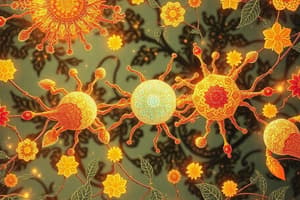Podcast
Questions and Answers
What does Emax represent in pharmacological terms?
What does Emax represent in pharmacological terms?
- The maximal effect of a drug (correct)
- The rate at which a drug is eliminated from the body
- The minimal effective concentration of a drug
- The concentration at which the effect is half maximal
Which statement correctly describes the relationship between EC50 and potency?
Which statement correctly describes the relationship between EC50 and potency?
- EC50 is only relevant for full agonists
- Potency is unaffected by EC50 values
- Lower EC50 values indicate higher potency (correct)
- A higher EC50 indicates greater potency
What characterizes a full agonist?
What characterizes a full agonist?
- It induces a submaximal response
- It causes 100% of the response when receptors are saturated (correct)
- It has no affinity for the receptors
- It can bind to receptors but not activate them
How does ligand B differ from ligand A according to the provided information?
How does ligand B differ from ligand A according to the provided information?
What does it mean when a ligand has the same affinity but lower efficacy compared to another ligand?
What does it mean when a ligand has the same affinity but lower efficacy compared to another ligand?
What term describes the primary binding site for an agonist on a receptor?
What term describes the primary binding site for an agonist on a receptor?
Which of the following statements about drug receptors is correct?
Which of the following statements about drug receptors is correct?
What type of curve is used to measure the drug response to systemically administered drugs?
What type of curve is used to measure the drug response to systemically administered drugs?
In pharmacodynamics, what does the term 'potency' refer to?
In pharmacodynamics, what does the term 'potency' refer to?
Which of the following is NOT a type of receptor activity?
Which of the following is NOT a type of receptor activity?
What is the key concept behind dose-response relationships in pharmacology?
What is the key concept behind dose-response relationships in pharmacology?
What does the therapeutic index measure?
What does the therapeutic index measure?
What is the significance of conformational changes in receptors after ligand binding?
What is the significance of conformational changes in receptors after ligand binding?
What is the relationship between affinity and efficacy in pharmacology?
What is the relationship between affinity and efficacy in pharmacology?
In a dose-response curve, what is typically depicted on the x-axis?
In a dose-response curve, what is typically depicted on the x-axis?
Which represents the primary measurement in an organ bath setup when testing drug effects on muscle tissue?
Which represents the primary measurement in an organ bath setup when testing drug effects on muscle tissue?
What unit is used to express drug doses in pharmacology?
What unit is used to express drug doses in pharmacology?
What does potency refer to in pharmacological terms?
What does potency refer to in pharmacological terms?
Which aspect is NOT typically represented in a sigmoidal dose-response curve?
Which aspect is NOT typically represented in a sigmoidal dose-response curve?
How is the effect of a ligand on a receptor quantified?
How is the effect of a ligand on a receptor quantified?
What does the logarithmic scale on the x-axis help illustrate in a dose-response curve?
What does the logarithmic scale on the x-axis help illustrate in a dose-response curve?
Study Notes
Receptor Theory
- Receptor theory: Main scientific theory of pharmacology
- "Receptor": Protein that recognizes and responds to endogenous signalling mediators.
- "Target": Anything a drug interacts with to cause an effect.
- Receptor theory developed by Langley, Clark, Gaddum, and Sir James Black.
Binding Sites
- Receptor has an active ("orthosteric") binding site for its endogenous, activating ligand (agonist)
- Binding sites have high specificity to endogenous agonists
- Ligand binding induces conformational changes to activate the receptor
- Receptors have secondary ("allosteric") binding sites for other ligands.
Dose-Response Curves
- Dose-response relationships: Measure the effect of a drug.
- More drug = more effect.
- Concentration-effect: Measuring effect of drug at target site.
- Dose-response curve: Measuring the response to a systemically administered drug.
- Types of responses: Cellular, Physiological, Subjective, Population.
Units
- [Substance]: Concentration of that substance (e.g. [Aspirin]).
- Concentration: Measured in molarity (M, or moles/litre).
- In medicine: Units of drug per kilogram of body weight (mg/kg).
Affinity & Efficacy
- Affinity: Ability of a ligand to bind to a target.
- Efficacy: Ability of a ligand to generate an effect.
- Together, affinity and efficacy determine potency.
D-R curves – Affinity & Efficacy
- Ligand A: High affinity and high efficacy.
- Ligand B: Lower affinity and same efficacy as A.
- Ligand C: Same affinity as A, but lower efficacy.
EC50 & Potency
- EC50: The concentration at which the effect is half maximal.
- Potency: Concentration of drug required to cause an effect, measured by EC50.
- Lower EC50 means more potent drug.
Full and Partial Agonists
- Full Agonists: Induce a maximal response when receptors are saturated.
- Partial Agonists: Induce a submaximal response.
Studying That Suits You
Use AI to generate personalized quizzes and flashcards to suit your learning preferences.
Related Documents
Description
Test your understanding of receptor theory in pharmacology, including the roles of binding sites and dose-response curves. This quiz covers key concepts such as agonists, receptor activation, and drug interactions. Challenge your knowledge on how these factors affect drug effects on the body.



